The history of the Ramakrishna Order’s relief services is as old as that of the Mission itself. Besides their multifarious permanent constructive works, from their very inception, the Ramakrishna Math and the Ramakrishna Mission have been ever ready to promptly organize ameliorative and healing services whenever the nation has been faced with sudden calamities caused by freaks of nature, follies of men, or scourges of epidemics. Its relief activities have also extended well beyond Indian borders.

The Ramakrishna Mission began its first organized relief operation within two weeks of its being founded. Since then relief has been a major plank of the humanitarian service programmes of the Ramakrishna Mission. Relief has been undertaken almost every year on different scales and in different forms in one part of the country or the other in response to both natural and man-made disasters. Flood relief is the most common type of relief operation and over the years about 30 different types of relief have been provided. In dispensing relief, the Mission meets the immediate and the long-term needs of victims, irrespective of their caste, gender, ethnicity, religion or political persuasion. These immediate needs are met through primary relief, which takes the form of distributing food, clothing, medicines and other necessities and providing temporary shelters. Long-term needs on the other hand range from constructing -houses and shelters to economic rehabilitation and follow-up programmes.
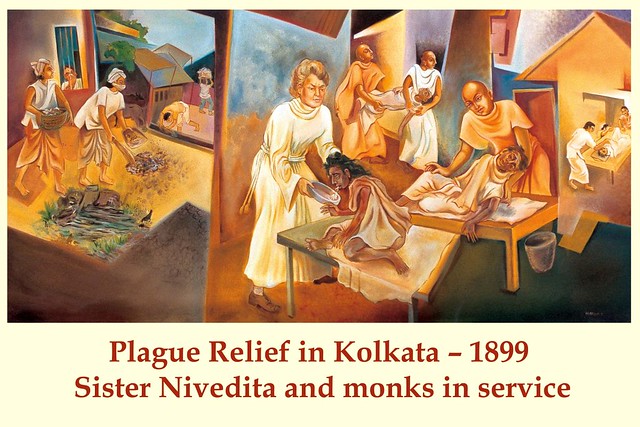
In the first few years the Ramakrishna Mission’s relief operations were mainly provided in Bengal, with a couple of isolated operations elsewhere. Subsequently, relief operations were extended beyond the borders of Bengal to include famine relief in Puri in 1908-09, Benaras in 1916-17; flood relief in Amherst in 1920-21 and Akyab (Burma , now Myanmar) in 1926-27, in the South like Coimbatore, Tanjore, Salem and Travancore in 1924-25 and in the North like Vrindaban, Mathura and Dehradun in 1924-25; earthquake relief was provided in Dharmasala in 1905-06, in Pegu in 1930-31 and North Bihar in 1934. The branching out of relief operations coincided with the expansion of the Ramakrishna Math and the Ramakrishna Mission through its branches across India. In the last 20 years, relief operations have also been provided abroad like in Russia, Brazil, Fiji, Sri Lanka and other places.
Relief Activities – A Documentary
Uttarakhand Relief – A Documentary
SOURCES OF INSPIRATION
The Ramakrishna Mission draws its inspiration from the lives and experiences of Sri Ramakrishna (1836-1886), Sri Sarada Devi (1853-1920) and Swami Vivekananda (1863-1902). All three of them were also confronted with the ravaging effects of famine on the Indian people.

Sri Ramakrishna was exposed to two situations – one at Deoghar and another at Kalaighata – where he persuaded Mathura Mohan Biswas to feed and clothe the famine-stricken people of the locality. Sri Ramakrishna’s encounter with the poverty-stricken at Deoghar, in around 1868, were most probably the lingering victims of the great Orissa famine of 1866.
There is also some possibility that the famine-stricken, whom Sri Sarada Devi served as a young girl at her native village, were also the victims of the same Orissa famine that affected parts of Bengal.
Swami Vivekananda, during his itinerant days, travelled through areas that were ravaged by famines in the past. His wanderings through the western frontiers of Bengal, Bihar and Oudh/United Provinces, in 1888 and 1889, had all experienced famines from 1876 to 1879. His far more extensive travels from 1890 to 1893 took him through many locations that were ravaged by famines in the previous quarter of a century. Hence, Swami Vivekananda was keenly aware that famines were not only a constant curse in the Indian subcontinent during the British regime, but that the government machinery was lacklustre and inefficient in responding to these effectively. An article, published in The Statesman on September 9, 1901, carried the findings of the Sir Anthony MacDonnell Famine Commission, which reported: “Wherever there was failure it was due not so much to defects in the system of relief (government relief) as to the defects in the administration of it.” Later, after his participation at the World’s Parliament of Religions, Swami Vivekananda was catapulted on the world’s stage. This paved the way for mobilizing a spiritually-centred organization that would work for ameliorating the effects of famine and other forms of socio-economic injustices with a definitive philosophy.
THE PHILOSOPHY OF SERVICE
But the means to this are legion. ‘Does God exist only when the eyes are closed and cease to exist when the eyes are opened?’ he observed. He also pointed out that ‘an empty stomach is no good for religion’, and himself took steps to mitigate such wants. Although he warned against philanthropy being demeaned by desire for name and fame, he commended selfless acts of charity as being ‘very noble’. He told Ishwar Chandra Vidyasagar, the famous educationist and humanitarian, ‘Though work for the good of others belongs to rajas, yet this rajas has sattva for its basis and is not harmful. Suka and other sages cherished compassion in their minds to give people religious instruction, to teach them about God. You are distributing food and learning. That is good too. If these activities are done in a selfless spirit they lead to God.’
On another occasion, while explaining the essential doctrine of Vaishnava religion, Sri Ramakrishna said, ‘Compassion for all beings! … No, no, it is not compassion to the jiva, but service to the jiva as Shiva.’ It was this idea that Swami Vivekananda developed into his philosophy of social service In a letter to his disciple, Sharat Chandra Chakraborty, on 3 July 1897, Swamiji wrote,
Here is a peculiarity: when you serve a Jiva with the idea that he is Jiva, it is Daya (compassion) and not Prema (love); but when you serve him with the idea that he is the Self, that is Prema. That the Atman is the one object of love is known from Shruti, Smriti, and direct perception. … Our principle, therefore, should be love, and not compassion. … For us, it is not to pity but to serve. Ours is not the feeling of compassion but of love, and the feeling of Self in all.
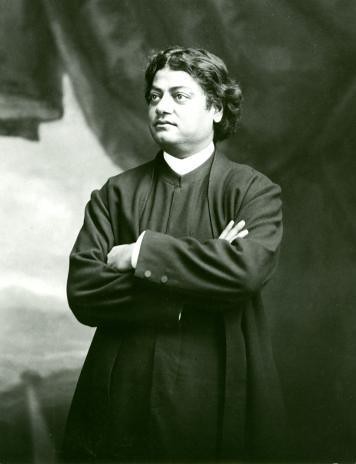
He coined the term daridra-narayana, God in the form of the poor, and asked us to serve Him: ‘Where should you go to seek God—are not all the poor, the miserable, the weak, Gods? Why not worship them first?’ This concept of ‘service as worship’ defines the outlook of the Ramakrishna Order in all its social-service undertakings.
Swami Vivekananda drew attention to four forms of service: ‘The gift of spirituality and spiritual knowledge is the highest, … the next gift is secular knowledge, … the next is the saving of life; and the fourth is the gift of food.’ He had a comprehensive ‘developmental perspective’ even for famine relief.
When Swami Akhandananda was involved in the Mission’s first famine relief, Swamiji wrote, ‘Akhandananda is working wonderfully at Mahula, but the system is not good. It seems they are frittering away their energies in one little village and that only doling out rice. I do not hear that any preaching has been done along with this helping. All the wealth of the world cannot help one little Indian village if the people are not taught to help themselves. Our work should be mainly educational, both moral and intellectual.’ This holistic-empowerment perspective remains the binding vision of the Order to this day.
The empowerment that Swamiji conceived of was based on practical or applied Vedanta. The Upanishads, Swamiji pointed out, are a mine of strength, for they reveal the Atman, the source of all power. He emphasized that ‘these conceptions of the Vedanta must come out, must remain not only in the forest, not only in the cave, but they must come out to work at the bar and the bench, in the pulpit and in the cottage of the poor man. … [For] if the fisherman thinks that he is the Spirit, he will be a better fisherman; if the student thinks he is the Spirit, he will be a better student …, and so on.’ For the members of the Ramakrishna Order, service is ‘Vedanta in practice’. We need to serve others because their suffering is, in fact, our own. Making them happy is the only way we can make ourselves happy.
This is the spirit behind Ramakrishna Mission’s relief activities. This definitive philosophy, which combines immense idealism with immense practicality, is encapsulated in the motto of the Ramakrishna Order, which is ‘Atmano mokshartham jagat hitaya cha’ or ‘For personal spiritual emancipation and collective well-being’. The immense idealism of the Vedanta philosophy which declares the divinity of man and the oneness of existence was combined with the immense practicality of identifying with this oneness of existence (or God) through service. In other words, monks and volunteers manifest their latent spirituality that culminates in unconditional individual freedom (Atmano-mokshartham) by serving God (or divinity) in man. Given that natural and man-made disasters disrupt the welfare in a community, relief is one of the most immediate and direct means of restoring the welfare (or Jagat hita) of an affected area.
GROWTH AND EXTENSION OF RELIEF SERVICES
 The Ramakrishna Mission has continually provided relief since May 1897 for over a century. Exhibit 1 depicts the growth in the average number of primary relief operations that were con-ducted by the Ramakrishna Mission between 1897 and 2009 in the different states of India in ten year intervals.
The Ramakrishna Mission has continually provided relief since May 1897 for over a century. Exhibit 1 depicts the growth in the average number of primary relief operations that were con-ducted by the Ramakrishna Mission between 1897 and 2009 in the different states of India in ten year intervals.
According to Exhibit 1 there has been a distinct rise in the average number of relief operations between 1917 and 1926. This was mainly on account of the flood relief operations that were undertaken in South India over this period. The most sustained rise in the average number of primary relief operations was from the late 1950s – a rise that has continued to the present. Another steep rise is noticeable in the late 1990s and early 2000s. Thus in the post-independence period there has been a marked and sustained growth in the number of primary relief operations.

Over the past century certain trends have emerged with respect to the types of relief. Flood relief has been a regular phenomenon since 1899 when the first flood relief operation was carried out at Bhagalpur. Cyclones and earthquakes strike every few years and the Ramakrishna Mission has almost always provided relief, whenever and wherever these have struck in India or its surrounding regions. In the pre-independence period, famine and medical relief, apart from floods, were the common types of relief operations. Medical relief included plague, cholera and small pox.
In the post-independence period, there were no famine relief operations conducted by the Ramakrishna Mission, even though drought relief was conducted from the 1960s. Drought is a major cause of famine, and it is interesting that drought relief is only a post-independence phenomenon in the Ramakrishna Mission. Medical relief, in the post-independence period, tended to become a component of other relief operations. Evacuee, refugee and riot relief were mainly provided from the early 1940s to the early 1970s, especially during the period preceding and following independence. These are some of the trends that emerge over the past century and beyond.
APPROACH TO RELIEF AND REHABILITATION
The Ramakrishna Mission’s approach to providing relief and rehabilitation has evolved and has been refined for over a century. The nerve centre of all relief operations in India is the Relief Department, which is located at the headquarters of the Ramakrishna Math and the Ramakrishna Mission, Belur Math. The Relief Department conducts relief operations independently or in collaboration with branch and sometimes private centres. Soon after it gets information about a disaster, which ranges from the media to hearing through the grape-vine, it ascertains the needs of victims and the localities where primary relief is to be conducted in two ways.

First, through its branch centres which are in close vicinity to the site of the disaster or second, by sending a special team of monks on its behalf. Subsequently, it coordinates and directs relief operation, again in collaboration with its branch centres or with the team that it deputed. The role of branch centres is vital in not only providing local information and knowledge (geographical, cultural, linguistic, etc.), but also human resources – both monastic and lay – in carrying out relief and rehabilitation services. If the Relief Department works independently, then the members that it deputes are conversant with the language, culture and geography of the locality. The Ramakrishna Mission’s approach to relief is best described by differentiating the demand side from the supply side of relief operations.
THE DEMAND SIDE
Once the decision is taken to begin a relief operation, the Mission conducts a preliminary survey to ascertain the local and immediate needs of the affected locality. The survey is conducted by monks in collaboration with volunteers. While cooked and dry food is common to all operations, a particular operation may also have special requirements like medical or other assistance. For primary relief, once the particular needs are determined and the supplies are on call, coupons (beneficiary identity cards) are circulated to victims and they are instructed to assemble at a particular location and at a particular time for distribution. In distributing coupons attempts are made to circulate these to those most in need. But it should be borne in mind that determining need is often contentious and the demand for relief always outweighs the supply that the Mission is able to provide.
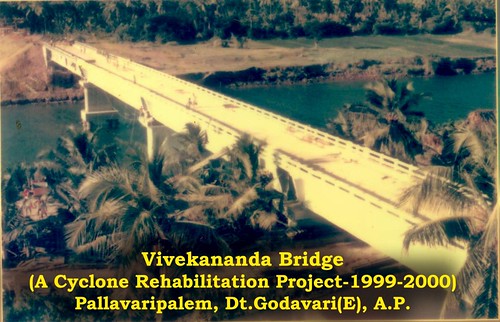
For rehabilitation, a more detailed survey is conducted, usually involving specialists in various fields. The specialists employed depend on the nature of the rehabilitation project. Rehabilitation takes a number of forms from building houses and shelter homes to economic rehabilitation. Some of the novel rehabilitation projects that the Mission has been involved with are cyclone-proof buildings, constructing a 120-metre bridge across Vruddha Gautami river, East Godavari, Andhra Pradesh – a first for any Non-Government Organization, economic and rural development at Latur, Maharashtra.
Exhibit 2 presents the average expenditure on primary relief and rehabilitation that the Ramakrishna Mission has incurred between 1975-76 and 2008-09 in roughly 10-year intervals. The expenditure of primary relief includes both direct expenditure and the value of goods donated in kind.
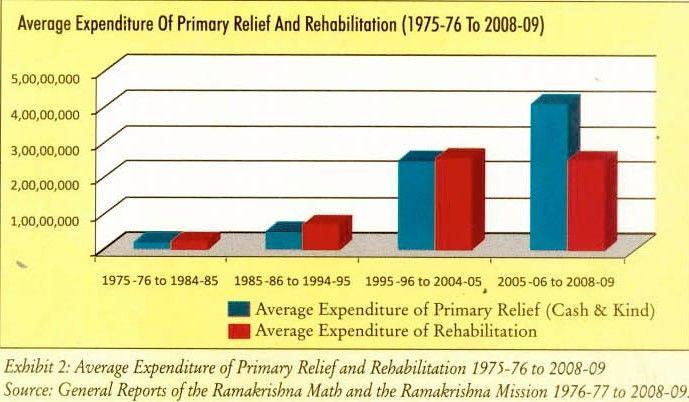
According to Exhibit 2 in the first three 10-year intervals (1975-76 to 1984-85, 1985-86 to 1994-95 and 1995-96 to 2004-05), the expenditure of primary relief and rehabilitation tended to increase side by side. In the latest period (2005-06 to 2008-09), however, the average expenditure of primary relief has tended to exceed the expenditure of rehabilitation. Indeed, there is a significant difference between the expenditure of primary relief and rehabilitation provided up to the mid-1990s to the present.
THE SUPPLY SIDE
The supply side comprises of material, human and financial resources. Material resources range from dry foods to utensils, which the headquarters deploys through its suppliers. At the time of a disaster, supplies may be sent directly to the location or to the headquarters. The approach of the headquarters with respect to human resources depends on the scale of the relief operation, locality, and existence of branches in close vicinity to the site of the disaster among other factors. Given that the Ramakrishna Mission does not maintain a permanent pool of monks or volunteers who only provide relief, all attempts are made to manage with personnel, both monastic and lay, from nearby branches to capitalize on their local knowledge and expertise. Hence these relief projects are an additional responsibility of centres on top of their day-to-day activities. But in the absence of branches, availability of monastic hands nearby or in the event of large scale operations other monks and volunteers may also be deployed. Relief operations are financed through public donations and philanthropic organizations in response to appeals or direct contact. Even though funding is project-based, the headquarters usually initiates relief operations from its Provident Relief Fund. Apart from financial support, the Mission also receives donations in kind from the public and administrative support from the government at times. All attempts are made to keep a judicious record and report everything received and supplied. The importance of this professionalism was stressed by Swami Vivekananda himself and is now a hallmark of the Ramakrishna Mission. A case in point is after the bridge across the Vruddha Gautami river, East Godavari, Andhra Pradesh, was completed, the financial surplus (about Rs. 25 lakhs) was handed over to the Andhra Pradesh Government.
KEY FEATURES OF THE APPROACH
- Worship of God in humans as the guiding ideal.
- Strictly apolitical conduct of activities and avoidance of populist publicity.
- Financial accountability through detailed records of the sources and utilization of funds.
- Reaching out to the most needy through careful field surveys.
- No discrimination on religious, ethnic, sectional or other grounds.
- Involvement of local people in planning as well as implementation of specific programmes.
- Rapid and efficient provision of services and use of current technology wherever feasible.
- Time-bound programmes and avoidance of ‘indiscriminate charity’ to prevent wastage of resources and dependence among beneficiaries.
- Participatory approach involving monks, volunteers and technical experts.
- Focus on development—socio-economic, environmental and cultural—empowerment, and preventive strategies in rehabilitation.
NATURAL DISASTERS
Natural disasters in India mainly take the form of earthquakes, floods, droughts, landslides, tornadoes, Tsunami, etc. Man-made disasters include arson, civil disorder, riots, etc. The main types of relief that the Ramakrishna Mission has provided in response to natural disasters over the last 50 years is summarized in Exhibit 3.
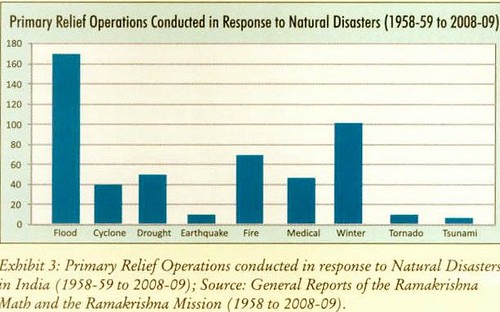
As depicted in Exhibit 3, flood relief is the most frequent type of primary relief operation that is conducted by the Ramakrishna Mission in response to natural disasters. This is followed by winter and fire relief. Winter relief has grown in the recent past and has taken the form of distributing blankets and garments to those from the lower socio-economic strata of society. In interpreting this graph, however, it should be borne in mind that it cannot differentiate between the scales of different relief operations. For example, it cannot differentiate between relief that is provided in 1 district or 12 districts, neither can it distinguish between different relief operations like between an earthquake relief and a winter relief operation. Still, even in view of these limitations, one gets a general idea of the most common types of primary relief operations that are conducted by the Ramakrishna Mission in the wake of natural disasters.
EARTHQUAKE

JANUARY 15, 1934, BIHAR: An earthquake, measuring 8.4 on the Richter scale, that rocked northern Bihar, was one of the worst in India’s history. The death toll was estimated at about 10,000 people, while another 10,000 were made homeless. The Ramakrishna Mission conducted primary relief through 14 centres and rehabilitation included the erection of 1993 temporary and 1428 semi-permanent huts, supplying cash or distributing materials for the erection of another 944 semi-permanent shelters etc. The Mission also repaired and cleaned houses and drinking water wells.
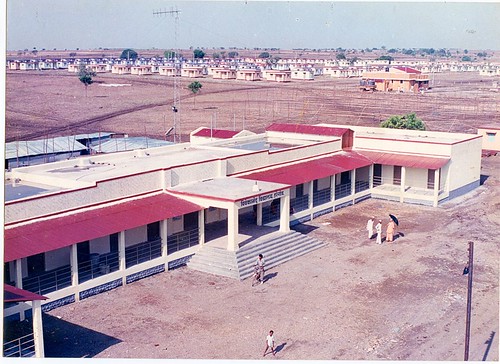
September 30, 1993, LATUR, MAHARASHTRA: The Latur earthquake took the lives of about 12,000 people and caused property damage that was estimated at Rs. 900 crores. Relief and rehabilitation were conducted by the Ramakrishna Mission between October 1993 and April 1999. Primary relief was provided in Haregaon and neighbouring villages to about 3000 families. Rehabilitation concentrated on three villages where 646 houses, 3 school shelters, 3 community prayer halls, and 6 children’s parks were constructed. The supply of water and electricity was also restored. A special feature of this project was a follow-up program for long-term socio-economic development. The total expenditure amounted to Rs. 5.25 crore.
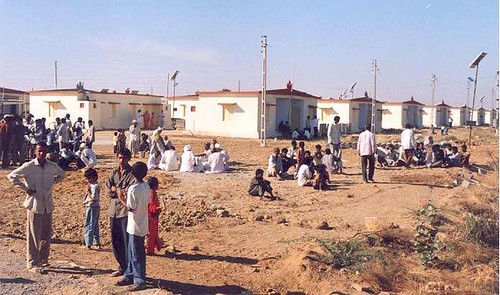
JANUARY 26, 2001, GUJARAT: An earthquake, measuring 6.9 on the Richter scale, affected 21 of the 25 districts in Gujarat. In Gujarat, relief began on the very day of the disaster and extended until March 2003. Thousands of victims benefited from the distribution of essential items in 281 villages in 5 of the 21 affected districts. Rehabilitation was provided in Porbandar, Rajkot, Surendranagar and Kutch districts. Here 390 quake-proof houses, 81 quake-proof schools, 5 community centres and 7 water reservoirs were built. Another 190 houses were made available under the ‘Build your own house scheme’. The total cost amounted to Rs. 20 crores.
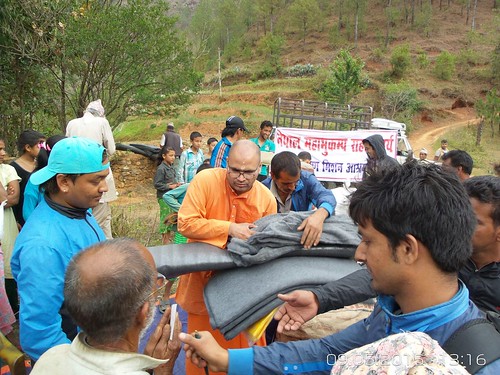
APRIL 25, 2015, NEPAL and INDIA: An earthquake struck Nepal and some parts of India with a magnitude of 7.8, followed by aftershocks including a large magnitude 7.3 quake on 12 May. The initial earthquake struck with an epicentre in the mountains to the northwest of Kathmandu, and aftershocks around the city of Kathmandu. The later 7.3 earthquake struck to the northeast of Kathmandu towards Mount Everest and affecting regions in Southern China. The quakes killed at least 8000 people and left many in desperate need of shelter, medical help, food and other aid. Primary relief was provided to 26, 598 families in 12 districts of Nepal and 2 districts of India from April 27, 2015, to Mar 2016. Medical assistance was provided to 3417 patients in this period.
DROUGHT

APRIL TO JULY 1986, WESTERN INDIA: Drought relief operations were conducted in the Sourashtra region for the four months ending in July. Distribution of cooking materials, water, clothes, and cattle fodder was provided to over 36, 833 persons belonging to 5107 families.
APRIL TO AUGUST 2000, WESTERN INDIA: The lack of rainfall in western India gave rise to a severe drought. The Ramakrishna Mission’s centres in Gujarat and Rajasthan conducted a drought relief operation that not only included the distribution of cooked and dry food, utensils and clothes, but also fodder, cattle feed, drinking water and medical assistance to thousands of cattle. The total expenditure amounted to Rs. 63.29 lakh.
FLOODS
The Ramakrishna Mission, since its first flood relief operation in Bhagalpur (Bihar) in 1899, has been providing flood relief almost every year. Two of the significant flood relief operations before independence were in South India from July to September 1924 and in Arakan (Burma, now Myanmar) from May to November 1936. The South Indian operation was massive where 7031 huts were built. The Arakan relief was undertaken despite the dangers posed by armed and dangerous bandits.


In the post-independence period, there was a considerable expansion in the Ramakrishna Mission’s flood relief services, in both North and South India. Some of the major operations in North East India were undertaken in 1954 by the Mission in Assam, West Bengal, Bihar, Orissa and East Pakistan (now Bangladesh). One of the biggest flood relief operations was brought about by the torrential monsoonal rains of 1978. In West Bengal, 25 relief camps were opened in 8 of the 11 affected districts. After providing primary relief, rehabilitation involved the construction of 260 Semi-permanent houses in four colonies, a primary Girls’ school, as well as tube wells and a community shelter.
CYCLONES
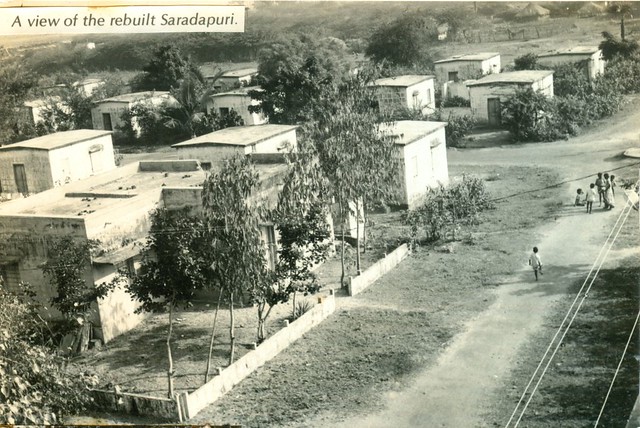
November 20, 1977, ANDHRA PRADESH & TAMIL NADU: A cyclone, which gave rise to tidal waves 6 metre high, affected Andhra Pradesh and Tamil Nadu. It was unprecedented in a century and did unimaginable devastation, killing 15,000 to 20,000 people. The Ramakrishna Mission’s primary relief included the distribution of food grains, utensils, clothes and other essentials. Rehabilitation at Tiruchi, Tamil Nadu included a housing colony with 57 permanent houses and two community halls. In ten villages of Andhra Pradesh, 1101 hurricane-proof houses, 8 community halls and temples were built. The total cost amounted to nearly Rs. 68.5 lakhs.
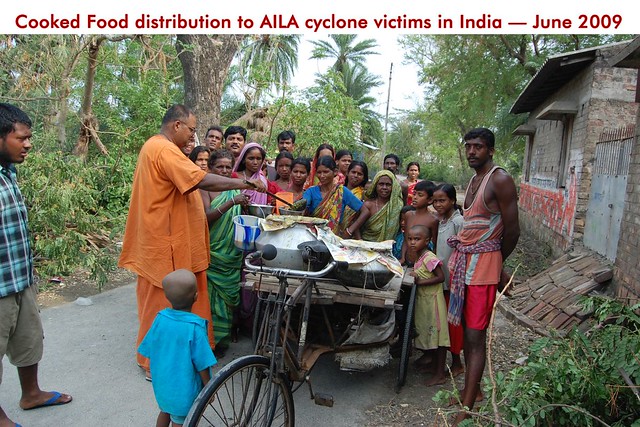
OCTOBER 29, 1999, ORISSA: A super cyclone, generating winds at 260 kmph and tidal waves 8 metre high ransacked the coast of Orissa. It was India’s strongest cyclone, taking the lives of over 10,000 people and affecting 1/3 of Orissa’s population. The Ramakrishna Mission began primary relief on November 1 1999. Primary relief was provided at 7 districts to about 10,000 families from November 1, 1999. Rehabilitation was provided at Kotang (Puri) and Kanaguli (Jagatsinghpur), where 330 cyclone-proof houses, 6 school-cum-cyclone-shelters, as well as 30 deep bore wells, were constructed. Total cost amounted to Rs. 5.5 crore.
TSUNAMI
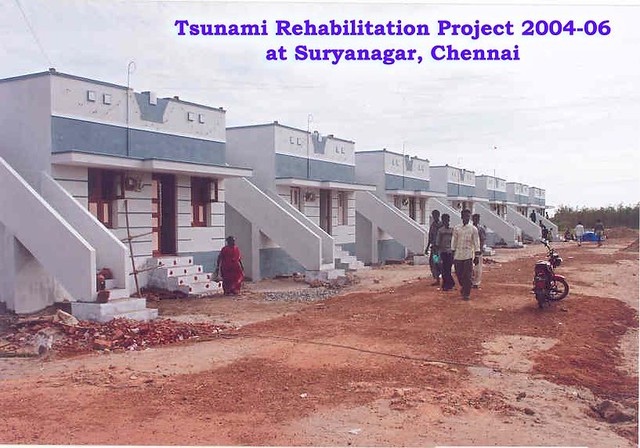
DECEMBER 26, 2004, SRI LANKA, ANDAMANS & TAMIL NADU: An earthquake, which hit the west coast of Sumatra and Andaman Islands, on December 26, 2004, gave rise to a Tsunami that devastated the coastal regions of Indonesia. India and Sri Lanka. Within a few hours the Mission organized relief through its centres at Chennai, Port Blair and Colombo. Primary relief was provided to about 2.6 lakhs victims through the centres at Chennai, Port Blair and Colombo. Rehabilitation was also conducted by these centres, which included the building of 324 houses, 4 community halls, distribution of 487 motor boats, 900 kg fishing nets, etc. and the total amount spent was Rs. 26 crore.
MAN-MADE DISASTERS
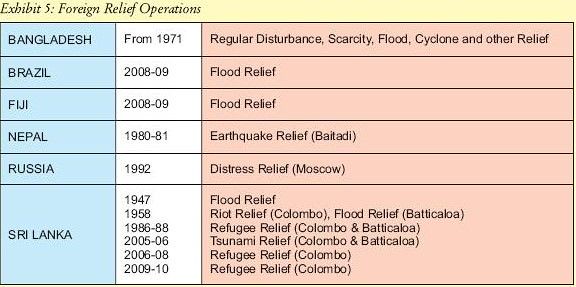
Man-made disasters are intentionally or unintentionally perpetrated by human beings. The most frequent types of man-made disasters in which the Ramakrishna Mission has provided primary relief are depicted in Exhibit 4. Distress relief is the most common type of relief that is provided in response to man-made disasters, especially in the recent past, taking the form of serving slum children and expectant mothers with milk. Evacuee and refugee relief operations are similar categories that refer to displaced persons who are served at refugee or transit camps.
The Ramakrishna Mission’s landmark operations in response to man-made disasters mainly occurred in the 1940s when India was at crossroads – between political subjugation and in dependence, between division and unity.
GREAT BENGAL FAMINE (1942-45): The Great Bengal Famine took the lives of about 3 to 4 million people. The British Government’s ‘scorched earth policy’ was reactionary to the Japanese army’s initial victory in Singapore and Burma and the potential threat of this to their dominion in India. This policy was intended to deprive the enemy of food and other essential infrastructure and was executed by profiteers who cut the supply of food to the bone. This resulted in the spiralling of food prices culminating in a man-made famine. The Mission conducted ‘Distress relief’, between June 1943 and April 1945. During the height of the operation, 75 distribution centres, spread over 19 districts, covering 1169 villages and 22 towns were conducted. The Mission also administered the Government’s Destitute Centre and the Government Orphanage, where 21,000 men and women, and 1200 orphans were served.

EASTERN FRONTIER (1942-43): During World War II, when Burma was on the brink of attack, a number of evacuees sought asylum in India. Many were physically exhausted and mentally afflicted by acts of cruelty while crossing the rugged terrain. Despite the risk of being casualties of war the Ramakrishna Mission entered the war zone in 1942. The Mission assisted about 3230 evacuees between 1942 and 1943 on the Eastern frontier of India.

EAST BENGAL & WEST PAKISTAN (1946-48): The period preceding and following the partition of India in August 1947 along religious demographics – between Muslim and Non-Muslim – was plagued by bitter and bloody conflict. The Great Calcutta killing took place on August 16, 1946. It occurred when the Muslim League protested Congress’s rejection of a proposal to divide India. The eruptions of communal violence in Calcutta soon spread to Noakhali, Tippera and other places. The Mission started riot relief on October 10, 1946, which continued till December 1948, over which period 140 villages in East Bengal were covered. Primary relief was complemented by rehabilitation which included agricultural assistance, restarting of schools, and the building of two students’ homes.
Communal violence in Punjab in March 1947 sparked off a one-off massive exodus. Non-Muslims settled in West Pakistan retreated to India, while Muslims of East Punjab left for Pakistan. The Mission provided relief at the Government’s largest refugee camp at Kurukshetra in East Punjab between October 1947 and May 1948, where it distributed fruit juice, blankets, multi-vitamin tablets, medicines, milk, garments and other goods.
EAST PAKISTAN EXODUS: In response to partition and recurrent violence in East Pakistan refugees scurried for West Bengal in fits and starts from 1946 to 1971. The Mission provided relief between 1947 and 1971. The first phase was conducted in cooperation with the West Bengal Government and took place between May 17, 1948 and March 16, 1949.The maximum number of recipients to be served in any week was 10,386.
The second phase of the relief was conducted from mid-March 1950. The Mission’s initial task was to feed around 12,000 refugees daily at Sealdah railway station. Subsequently 19 centres were opened across West Bengal, Bihar, Assam, Tripura and East Pakistan on the Mission’s resources and in collaboration with the Government. Later refugees were rehabilitated in the states bordering East Pakistan in West Bengal. Tripura and Assam. East Bengal refugees were again provided primary relief in the mid-19605 and rehabilitated at a settlement at Dandakaranya in Madhya Pradesh. In response to the 1970 exodus, 29 transit camps functioned between April 1971 and January 1972 in villages and towns bordering West Bengal, Assam and Tripura. The Mission spent Rs. 27.25 lakhs to alleviate the miseries of about 2 lakh evacuees.
DISTRIBUTION

India has experienced phenomenal growth in GDP over the last few years. But this has not trickled down to all. Those in the lowest strata of society in India continue to live in subsistence – from hand to mouth and suffer from malnutrition and socio-economic exclusion. In the last few years, the Ramakrishna Mission, through its Relief Department and participating branch centres has tried to improve the condition of those in abject poverty. It does this by distributing milk and blankets to those who live in shanties and slums in close vicinity to the branch centres of the Ramakrishna Math and the Ramakrishna Mission. Poor children and malnourished mothers are provided milk through many centres.

The headquarters distribute 30 to 40 metric tons of milk powder each year at the cost of about Rs. 40 to 50 lakhs. It purchases the milk from suppliers and dispatches it to the branches from where it is distributed. On an average one hundred beneficiaries are provided milk daily by each of the participating centres throughout the year. At some of the centres, milk is accompanied with tiffin. On account of this project there has been a marked improvement in the health, nutrition and educational performance of the children.

Distributing blankets to the destitute during winter is another way in which the Ramakrishna Mission provides regular relief. Each year an average of about 50,000 blankets are distributed by about 58 centres across India at the cost of more than Rs. 50 lakhs to headquarters. Headquarters purchases the blankets and distributes these through its branch centres after conducting a survey.
OPERATIONS
The Ramakrishna Mission’s relief operations have not been confined to India only. It has also been providing relief services abroad. Relief operations in Bangladesh and Sri Lanka are conducted quite regularly and on a large scale. Some of these operations are outlined below.
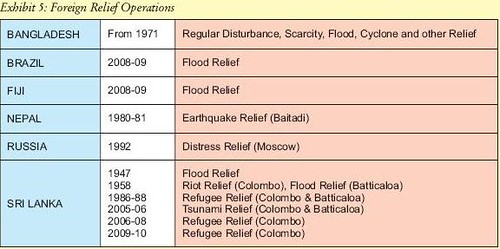
CONCLUSION
The Ramakrishna Mission has been dispensing relief in the wake of natural and man-made disasters in India and abroad. The distinguishing features of the Mission’s relief services are its sources of inspiration and commitment to an ideal, an organizational network and experience of providing relief continually for over a century. Its sources of inspiration are Sri Ramakrishna, Sri Sarada Devi and Swami Vivekananda and the ideal that it is committed to is ‘Atmano mokshartham jagat hitaya cha’. Its organizational network through branch centres, monks and volunteers, suppliers of relief goods enables it to meet the immediate and long term needs of victims affected by disasters. The Mission’s approach is to meet the immediate needs of victims through primary relief and long-term needs through rehabilitation and follow up, which many other NGOs now emulate. Even though the scale of the Mission’s relief operations may not be as large as some of the international NGOs, it has a wealth of experience that has been accumulated for over a century by uninterruptedly providing relief. This is in spite of not maintaining a permanent pool of monks or volunteers solely for this purpose. In dispensing relief, the Mission has won laurels in India and abroad. Rather than resting on these laurels the Ramakrishna Mission marches on and does what it does best – the service of God in man.
